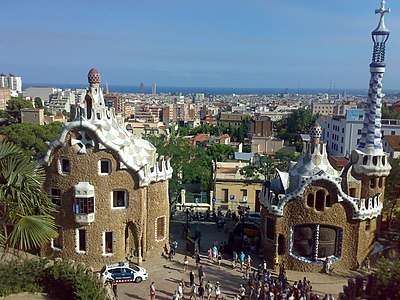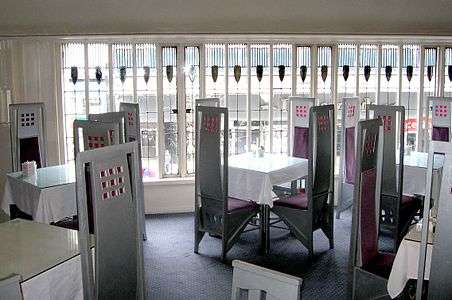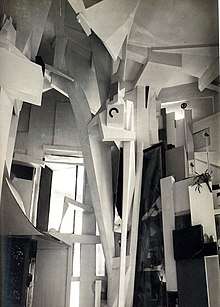Gesamtkunstwerk
A Gesamtkunstwerk (German: [gəˈzamtˌkʊnstvɛʁk], literally "total artwork", frequently translated as "total work of art",[1] "ideal work of art",[2] "universal artwork",[3] "synthesis of the arts", "comprehensive artwork", or "all-embracing art form") is a work of art that makes use of all or many art forms or strives to do so. The term is a German loanword which has come to be accepted in English as a core term in aesthetics.
Background
The term was developed by the German writer and philosopher K. F. E. Trahndorff in an essay in 1827.[4] The German opera composer Richard Wagner used the term in two 1849 essays, and the word has become particularly associated with his aesthetic ideals.[5] It is unclear whether Wagner knew of Trahndorff's essay.
In the 20th century, some writers applied the term to some forms of architecture, while others applied it to film and mass media.[6]
In opera
Before Wagner
Some elements of opera, seeking a more "classical" formula, had begun at the end of the 18th century. After the lengthy domination of opera seria, and the da capo aria, a movement began to advance the librettist and the composer in relation to the singers, and to return the drama to a more intense and less moralistic focus. This movement, "reform opera" is primarily associated with Christoph Willibald Gluck and Ranieri de' Calzabigi. The themes in the operas produced by Gluck's collaborations with Calzabigi continue throughout the operas of Carl Maria von Weber, until Wagner, rejecting both the Italian bel canto tradition and the French "spectacle opera", developed his union of music, drama, theatrical effects, and occasionally dance.
However these trends had developed fortuitously, rather than in response to a specific philosophy of art; Wagner, who recognised the reforms of Gluck and admired the works of Weber, wished to consolidate his view, originally, as part of his radical social and political views of the late 1840s. Previous to Wagner, others who had expressed ideas about union of the arts, which was a familiar topic among German Romantics, as evidenced by the title of Trahndorff's essay, in which the word first occurred, "Aesthetics, or Theory of Philosophy of Art". Others who wrote on syntheses of the arts included Gotthold Ephraim Lessing, Ludwig Tieck and Novalis.[7] Carl Maria von Weber's enthusiastic review of E.T.A. Hoffmann's opera Undine (1816) admired it as 'an art work complete in itself, in which partial contributions of the related and collaborating arts blend together, disappear, and, in disappearing, somehow form a new world'.[8]
Wagner's ideas
Wagner used the exact term 'Gesamtkunstwerk' (which he spelt 'Gesammtkunstwerk') on only two occasions, in his 1849 essays "Art and Revolution" and "The Artwork of the Future",[9] where he speaks of his ideal of unifying all works of art via the theatre.[10] He also used in these essays many similar expressions such as 'the consummate artwork of the future' and 'the integrated drama', and frequently referred to 'Gesamtkunst'.[7] Such a work of art was to be the clearest and most profound expression of folk legend.
Wagner felt that the Greek tragedies of Aeschylus had been the finest (though still flawed) examples so far of total artistic synthesis, but that this synthesis had subsequently been corrupted by Euripides. Wagner felt that during the rest of human history up to the present day (i.e. 1850) the arts had drifted further and further apart, resulting in such "monstrosities" as Grand Opera. Wagner felt that such works celebrated bravura singing, sensational stage effects, and meaningless plots. In "Art and Revolution", Wagner applies the term 'Gesamtkunstwerk' in the context of Greek tragedy. In "The Art-Work of the Future", he uses it to apply to his own, as yet unrealized, ideal.
In his extensive book Opera and Drama (completed in 1851), Wagner takes these ideas further, describing in detail his idea of the union of opera and drama (later called music drama despite Wagner's disapproval of the term), in which the individual arts are subordinated to a common purpose.
Wagner's own opera cycle Der Ring des Nibelungen, specifically its components Das Rheingold and Die Walküre, represent perhaps the closest he, or anyone else, came to realizing these ideals.[11] He was himself after this stage to relax his own strictures and write more 'operatically'.[12]
In architecture

Some architectural writers have used the term Gesamtkunstwerk to signify circumstances where an architect is responsible for the design and/or overseeing of the building's totality: shell, accessories, furnishings, and landscape.[13] It is difficult to make a claim for when the notion of the Gesamtkunstwerk was first employed from the point of view of a building and its contents (although the term itself was not used in this context until the late 20th century); already during the Renaissance, artists such as Michelangelo saw no strict division in their tasks between architecture, interior design, sculpture, painting and even engineering.
Historian Robert L. Delevoy has argued that Art Nouveau represented an essentially decorative trend that thus lent itself to the idea of the architectural Gesamtkunstwerk. Of course, it is equally possible it was born from social theories that arose out of a fear of the rise of industrialism.[14]
Nonetheless, evidence of complete interiors that typify the concept of Gesamtkunstwerk can be seen from some time before the 1890s. An increasing trend among architects in the 18th and 19th centuries was to control every facet of an architectural commission. As well as being responsible for the structure itself, they tried to extend their role to also include designing (or at least vetting) every aspect of the interior work. This included not only the interior architectural features but also the design[15] of furniture, carpets, wallpaper, fabrics, light fixtures, and door-handles. Robert Adam and Augustus Welby Pugin are examples of this trend to create an overall harmonising effect which in some cases might even extend to the choice or design of table silver, china, and glassware.
Art Nouveau
Gesamtkunstwerk was typical for Art Nouveau artists. Belgians Victor Horta and Henry Van de Velde, Catalan Antoni Gaudí, French Hector Guimard, Scottish Charles Rennie Mackintosh, Austrian Josef Hoffmann, Russian German Franz (Fyodor) Schechtel, and many other architects also acted as furniture and interior designers. Also, many of Art Nouveau masterpieces were results of cooperation of artists of different fields:
- Villa Majorelle (1901-1902) in Nancy, France was created by architect Henri Sauvage, furniture designer Louis Majorelle, ceramist Alexandre Bigot, and stained glass artist Jacques Grüber,
- The Municipal House (1904-1912) in Prague, Czech Republic was designed by Osvald Polívka and Antonín Balšánek, painted by famous Czech painter Alphonse Mucha and features sculptures of Josef Mařatka and Ladislav Šaloun,
- The Gresham Palace (1904-1906) in Budapest, Hungary is was created by architects by Zsigmond Quittner and Jozsef Vago, sculptors Géza Maróti, Miklós Ligeti, and Ede Telcs, stained glass artist Miksa Róth and metalwork artist Gyula Jungfer.
- Works of Victor Horta[16]
- Hôtel Tassel,[17] Hôtel Solvay,[18] and Hôtel van Eetvelde[17] were created in cooperation with stained glass master Raphaël Évaldre,
- Maison and Atelier Horta was created in cooperation with sculptor Pieter Braecke[19]
- Works of Lluís Domènech i Montaner:[20] Palau de la Música Catalana and Hospital de Sant Pau in Barcelona
- sculptors Pablo Gargallo, Eusebi Arnau, and mosaic master Mario Maragliano took part in both projects,
- sculptor Miguel Blay, stained glass master Antoni Rigalt, ceramist Lluis Brù i Salelles were involved in construction of Palau de la Música Catalana,
- metalwork artist Josep Perpinyà was involved in construction of Hospital de Sant Pau,
- Works of Antoni Gaudí:[21] Park Güell, Palau Güell, Sagrada Família, Casa Batlló, Casa Milá, Casa Vicens in Barcelona; Colònia Güell in Santa Coloma de Cervelló)
- mosaic master Mario Maragliano was involved in construction of Sagrada Família,
- architect Francesc Berenguer i Mestres was involved in construction of Sagrada Família and Colònia Güell,[22]
- architect Joan Rubió was involved in construction of La Sagrada Familia, Casa Batlló, and Parc Güell,
- artist of many genres Josep Maria Jujol helped Gaudí with Casa Batlló, Casa Milà, and Park Güell.
- Stoclet Palace in Brussels[23] was created by architect and designer Josef Hoffmann, painters Gustav Klimt, Fernand Khnopff, sculptor Franz Metzner, and mosaic master Leopold Forstner.[24] The construction of the palace foreshadowed Art Deco and the Modern architecture.[23]
.jpg) Detail of Stoclet Palace in Brussels (1905-1911)
Detail of Stoclet Palace in Brussels (1905-1911) Interior of Palau de la Música Catalana in Barcelona (1905-1909)
Interior of Palau de la Música Catalana in Barcelona (1905-1909) Entrance buildings in Parc Güell by Antoni Gaudí in Barcelona (1900-1914)
Entrance buildings in Parc Güell by Antoni Gaudí in Barcelona (1900-1914)%2C_Prague_-_8856.jpg) Main entrance of the Municipal House in Prague
Main entrance of the Municipal House in Prague
 The Gresham Palace in Budapest
The Gresham Palace in Budapest
Museum Villa Stuck is the work of artist Franz von Stuck and "was celebrated as a marvelously modern yet curious construction. Built along his guiding principle of the "Gesamtkunstwerk" the Villa Stuck combined all aspects of architecture, art, music, theatre, and life within its walls and garden".[25]
In Switzerland, Bruno Weber Park, a sculpture garden by artist Bruno Weber, is a later example of an Art Nouveau a piece inspired by Gesamtkunstwerk.[26]
Modernism
Similarly, Centre Le Corbusier is an example by famed Modernist architect Le Corbusier.[27]
In art

The multi-media style pioneered by Dadaists such as Hugo Ball has also been called a Gesamtkunstwerk.[28] 'Towards the Merz Gesamtkunstwerk' was a University of Oregon graduate seminar that explored themes of Dadaism and Gesamtkunstwerk, especially Kurt Schwitter's legendary Merzbau.[29] They cite Richard Huelsenbeck in his German Dada Manifesto: "Life appears as a simultaneous confusion of noises, colours and spiritual rhythms, and is thus incorporated — with all the sensational screams and feverish excitements of its audacious everyday psyche and the entirety of its brutal reality — unwaveringly into Dadaist art".[30][31]
Saatchi Gallery in London held a survey exhibition of 24 contemporary German artists in 2011, it was titled: Gesamtkunstwerk: New Art from Germany[32]
An exhibition entitled Utopia Gesamtkunstwerk, curated by Bettina Steinbrügge and Harald Krejci, took place from January to May 2012 at the 21er Haus in Belvedere, Vienna. "A contemporary perspective of the historical idea of the total work of art" was presented and included a "display" by Esther Stocker which was based on the idea of "the untidy nursery",[33] it housed works by Joseph Beuys, Monica Bonvicini, Christian Boltanski, Marcel Broodthaers, Daniel Buren, Heinz Emigholz, VALIE EXPORT, Claire Fontaine, gelatin, Isa Genzken, Liam Gillick, Thomas Hirschhorn, Ilya Kabakov, Martin Kippenberger, Gordon Matta-Clark, Paul McCarthy, SUPERFLEX, Franz West, and numerous others.[34] There was an accompanying book produced with the same name exploring the topic.[35]
In 2017, prominent visual artists Shirin Neshat and William Kentridge directed operas at the Salzburg Festival.[36]
Performer, video producer, and "bureaucratic wunderkind"[37] Brian David Gilbert of the video game website Polygon cited Gesamtkunstwerk as an inspiration in foundational technique in his rendition of the PokéRAP.[38][39]
Other applications
The Catholic Mass has been cited as an example of a Gesamtkunstwerk, and if such a correlation is deemed valid then one could rightly consider various liturgical expressions to be similar examples.[40]
The Total Art of Stalinism: Avant-Garde, Aesthetic Dictatorship, and Beyond is a 2011 book by Boris Groys which explores the comprehensive aesthetic reorganization of society in the USSR under Stalin's totalitarianism.[41]
Canadian development corporation Westbank, founded by Ian Gillespie, uses Gesamtkunstwerk as the founding idea behind the company's vision and philosophy for urban development.[42][15]
See also
- Gesaffelstein – French electronic music artist; Gesaffelstein being a portmanteau of Gesamtkunstwerk and Albert Einstein
- Dada
- Romanticism
- Towards the Merz Gesamtkunstwerk – website for a University of Oregon graduate seminar
References
- Millington (n.d.), Warrack (n.d.)
- Oxford English Dictionary, Gesamtkunstwerk
- ArtLex Art Dictionary Archived 2016-08-14 at the Wayback Machine
- Trahndorff (1827), Ästhetik oder Lehre von Weltanschauung und Kunst
- "Richard Wagner's Concept of the 'Gesamtkunstwerk'". Interlude.hk. Retrieved 2016-05-08.
- For discussions of architecture as Gesamtkunstwerk, see the relevant section of this article. For discussions of film and mass media, see for instance Matthew Wilson Smith, The Total Work of Art: From Bayreuth to Cyberspace. New York: Routledge, 2007; Carolyn Birdsall, Nazi Soundscapes: Sound, Technology, and Urban Space in Germany, 1933–1945. Amsterdam: Amsterdam University Press, 2012. pp. 141–72; and Jeongwon Joe, "Introduction: Why Wagner and Cinema? Tolkien Was Wrong." In Wagner and Cinema, edited by Jeongwon Joe and Sander L. Gilman, 1–26. Indiana: Indiana University Press, 2010.
- Millington (n.d.)
- Strunk, Oliver (1965). Source Readings in Music History: The Romantic Era. New York. p. 63. Archived from the original on 2005-05-02. Retrieved 2008-05-10.
- Wagner (1993), p. 35, where the word is translated as 'great united work'; p. 52 where it is translated as 'great unitarian Art-work'; and p. 88 (twice) where it is translated as 'great united Art-work'.
- Warrack (n.d.), Gesamtkunstwerk is incorrect in saying that Wagner used the word only in "The Artwork of the Future"
- Grey (2008) 86
- Millington (1992) 294–95
- Michael A. Vidalis, "Gesamtkunstwerk – 'total work of art'", Architectural Review, June 30, 2010.
- Robert L. Delevoy, 'Art Nouveau', in Encyclopaedia of Modern Architecture. Thames & Hudson, 1977.
- "Home - GESAMTKUNSTWERK". GESAMTKUNSTWERK. Retrieved 2017-12-28.
- World Heritage Centre, UNESCO. "Major Town Houses of the Architect Victor Horta (Brussels)". whc.unesco.org.
- Ouvrage collectif sous la direction de Philippe Roberts-Jones, Bruxelles fin de siècle, Flammarion, 1994, p.182
- Schoonbroodt, B, Art Nouveau Kunstenaars in Belgie, 2008: p. 196
- Metdepenninghen, Catheline; Celis, Marcel M. (2010). Pieter Braecke, beeldhouwer 1858-1938. Als de ziele luistert (in Dutch). Agentschap erfgoed van de Vlaamse Overheid. p. 56. ISBN 9789040302947.
- https://whc.unesco.org/en/list/804/multiple=1&unique_number=950 Official List of the UNESCO site "Palau de la Música Catalana and Hospital de Sant Pau, Barcelona" (1997)
- https://whc.unesco.org/en/list/320/multiple=1&unique_number=364 Official List of the UNESCO Site "Works of Antoni Gaudí" (1994, 2005)
- Cèsar Martinell. Gran Enciclopèdia Catalana, 2007
- https://whc.unesco.org/en/list/1298 Official List of the UNESCO Site "Stoclet Palace"
- "Palais Stoclet ist Weltkulturerbe". www.oe24.at. 2009-06-27. Retrieved 2016-06-10.
- Borsche, Bureau. "Museum Villa Stuck". bureauborsche.com. Retrieved 2019-11-28.
- http://www.gardensofswitzerland.ch/lang_EN/giardini-scheda.php?id=222
- https://www.archdaily.com/322782/ad-classics-centre-le-corbusier-heidi-weber-museum-le-corbusier
- John Elderfield, “Introduction”; Flight out of Time by Hugo Ball; University of California Press, 1996; xiii-xlvi.
- "About · Towards the Merz Gesamtkunstwerk". digitalarthistory607.omeka.net. Retrieved 2019-11-28.
- "DADA Manifesto Berlin April 191". ieeff.org. Retrieved 2019-11-28.
- "Exhibition Introduction · Towards the Merz Gesamtkunstwerk". digitalarthistory607.omeka.net. Retrieved 2019-11-28.
- Magazine, Wallpaper* (2011-11-17). "'Gesamtkunstwerk' show at Saatchi Gallery, London". Wallpaper*. Retrieved 2019-11-27.
- Utopie Gesamtkunstwerk / Utopia Gesamtkunstwerk, retrieved 2019-11-27
- "Utopie Gesamtkunstwerk | Belvedere". www.belvedere.at. Retrieved 2019-11-27.
- Utopia Gesamtkunstwerk. Krejci, Harald., Husslein-Arco, Agnes., Steinbrügge, Bettina., 21er Haus (Österreichische Galerie Belvedere). Köln: Verlag der Buchhandlung Walther König. 2012. ISBN 978-3-86335-140-3. OCLC 785864884.CS1 maint: others (link)
- "The Return of the Gesamtkunstwerk? Why Artists Are Flocking to the Opera House". artnet News. 2017-08-23. Retrieved 2019-11-27.
- Smash Bros. owes millions of dollars in OSHA violations | Unraveled, retrieved 2019-12-23
- Polygon (2019-04-07), The Perfect PokéRap | Unraveled LIVE at PAX East 2019, retrieved 2019-04-08
- Twin Galaxies (2019-04-08), Polygon's Brian David Gilbert Creates the Perfect Pokemon Rap
- Nancy Pedri and Laurence Petit (Editors), Picturing the Language of Images; Cambridge Scholars Publishing, 2013; pp. 360, 365.
- Groĭs, Boris. The total art of Stalinism : avant-garde, aesthetic dictatorship, and beyond. ISBN 978-1-78168-972-1. OCLC 1052165084.
- Perkins, Martha (2014-03-20). "Vancouver House introduces gwerk to the world". Vancouver Courier.
Bibliography
- Bergande, Wolfram: "The creative destruction of the total work of art. From Hegel to Wagner and beyond", in: Ruhl (Ed.): The death and life of the total work of art, Berlin: Jovis, 2014
- Finger, Anke and Danielle Follett (eds.) (2011) The Aesthetics of the Total Artwork: On Borders and Fragments, The Johns Hopkins University Press
- Grey, Thomas S. (ed.) (2008) The Cambridge Companion to Wagner, Cambridge University Press. ISBN 978-0-521-64439-6
- Koss, Juliet (2010) Modernism After Wagner, University of Minnesota Press, ISBN 978-0-8166-5159-7
- Krejci, Harald, Agnes Arco, and Bettina Steinbrügge. Utopia Gesamtkunstwerk. Köln: Verlag der Buchhandlung Walther König, 2012. ISBN 9783863351403
- Millington, Barry (ed.) (1992) The Wagner Compendium: A Guide to Wagner's Life and Music. Thames and Hudson Ltd., London. ISBN 0-02-871359-1
- Millington, Barry (n.d.) "Gesamtkunstwerk", in Oxford Music Online (subscription only) (consulted 15.9.2010)
- Roberts, David (2011) "The Total Work of Art in European Modernism", Cornell University Press, Ithaca, NY
- Trahndorff, Karl Friedrich Eusebius (1827) Ästhetik oder Lehre von Weltanschauung und Kunst
- Wagner, Richard (1993), tr. W. Ashton Ellis The Art-Work of the Future and Other Works. Lincoln and London, ISBN 0-8032-9752-1
- Warrack, John (n.d.) "Gesamtkunstwerk" in The Oxford Companion to Music online, (subscription only) (consulted 15 September 2069)
External links
